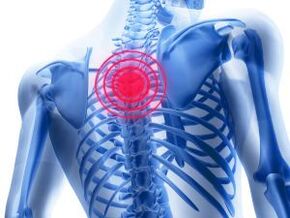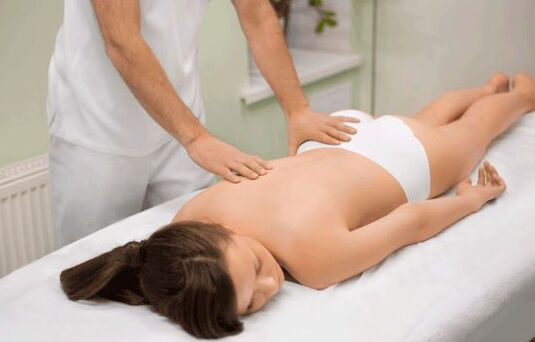
Clinically, thoracic osteochondrosis (chondrosis) is manifested by severe, penetrating or dull, aching pain when bending, cramping and clicking, stiffness.
Symptoms characteristic of the pathology and many specific symptoms include shortness of breath when breathing, discomfort in the heart and even a sore throat.
Treatment of pathology is predominantly conservative with pharmacological drugs. Physiotherapy procedures, massage sessions and chiropractors are also used.
If such treatment is ineffective, the patient is shown surgery.
Details of symptoms
Symptoms of osteochondrosis of the thoracic spine never appear all at once. At the initial stage of development of this degenerative-dystrophic pathology is observed only mild discomfort in the back. Patients take them for banal fatigue after a hard day of work, write off the muscles "numb" due to prolonged stay in one position of the body.
But the intensity of the discomfort increases slowly, steadily. Unpleasant sensations will be replaced by severe pain, complicated by limited range of motion, dizziness and headache. In medicine, all the symptoms of osteochondrosis of a given localization are divided into several groups. This helps in its faster diagnosis and determination of treatment tactics.
On a note!Symptoms of thoracic osteochondrosis in men and women do not differ in character, severity, and localization. But in the stronger sex, they may arise a little later due to a strong muscular system. Also, some men have erectile dysfunction on the background of osteochondrosis.
Spine symptoms
Under the influence of unfavorable factors (hypothermia, increased physical activity), long-term remission of thoracic osteochondrosis can be stopped by a sudden onset of acute pain. More often, it is provoked by prolonged stay in one position of the body, for example, in a sitting position. If a person stands sharply, then there is such severe pain in the back that he loses the ability to move for several minutes.
In medicine this condition is called Dorsago. It differs from normal pain in the following symptoms:
- Feeling short of breath while breathing;
- Heavy strength.
The course of the pathology is often complicated by dorsalgia - pain in the chest, the intensity of which gradually increases. It grows by bending, turning the body sideways. In order not to experience pain, the person takes a forced position. At the same time, it inadvertently strains the spinal muscles, inadvertently causing them to overload. Now they also start to ache, especially while walking.
Extravertebral symptoms
Chest osteochondrosis develops, the intervertebral discs are thin and destroyed. These cartilaginous pads can no longer distribute the resulting loads, eliminating the impact of the spine against each other. Compensatory reaction of the body begins - the bone structures begin to deform with the formation of growths. They cling to sensitive nerve endings, disrupting the spinal canal. Thus, in women and men, there are specific symptoms of thoracic osteochondrosis: loss of sensation in certain parts of the body, a burning sensation, and creeping "goose bumps. "
ᲛImportant! Osteochondrosis of the localized chest is often manifested by dry, unproductive cough, sore throat, coma, as well as urinary incontinence.
But that is not all. The roots of the spine are responsible not only for the innervation of the spine (transmission of nerve impulses), but also for the internal organs. Therefore, when they are violated, there are uncomfortable sensations in the liver, kidneys, digestive tract, myocardium. What are the typical signs for spinal pathologies manifested by thoracic osteochondrosis:
- Pain in the heart, identical to the recurrence of angina, shortness of breath, a feeling of "compression" of the heart;
- Panic attacks, psycho-emotional instability, unfounded fear, anxiety, sleep disturbance;
- Discomfort in the epigastric region, nausea attacks, sometimes causing vomiting, acid bumps, bloating, tingling and murmurs in it;
- Peristaltic disorders - constipation or diarrhea;
- Prolonged, laborious breathing with crying.
The pain is not localized directly at the site of the ruptured intervertebral disc and (or) an intervertebral hernia has formed. They radiate along the nerve. Signs of osteochondrosis of the chest region can be disguised as renal colic, gastritis symptoms, stomach ulcers, hepatitis, pancreatitis, cholecystitis and even gastroenteritis.
Compression myelopathy
This is the name of the extravertebral syndrome, which is rarely found in clinical practice. It is observed in stages 3-4 of the disease, when due to loss of stability by the spinal segment, the nuclear pulp protrudes beyond the annulus fibrosus. An intervertebral hernia is formed, which constantly presses on the spinal cord. When making an appointment with a vertebrologist or neurologist, patients complain of frequent girdle pain that radiates to the groin area. At the same time, there is a feeling of weakness, numbness of the lower extremities.
In the background of a spinal cord disorder, innervation is severely impaired. In the absence of treatment, the functional activity of the organs located in the small pelvis decreases. Compression myelopathy causes bowel movement problems. And due to the drastic narrowing of the spinal canal diameter, the sensitivity of the legs decreases. In severe cases, patients are diagnosed with one or two lower extremity paresis (partial or complete paralysis).
Symptoms of remission
Outside of relapses, chest osteochondrosis almost does not bother a person. Sometimes there is excruciating pain that usually disappears after a long rest. But it is worth at least slightly increasing the load on the spine, lifting a heavy object or deviating as the next recurrence. This can be caused by the following factors:
- Stressful situations, depressive states;
- Hypothermia, sudden changes in temperature;
- Prolonged stay in one position of the body;
- Alcohol abuse;
- Unbalanced diet, lack of foods containing calcium, phosphorus, manganese, molybdenum in the diet.
Sometimes the remission phase ends as the person tries to prevent another recurrence. She visits a chiropractor or massage therapist with a dubious reputation or little practical experience. Attempting to stretch the spine causes another aggravation.
Basic methods of treatment
It is not yet possible to completely cure the pathology, so all the efforts of doctors are aimed at improving the well-being of the patient. Patients are advised to wear orthopedic products (corsets, bandages) that fix the structures of the spine, preventing them from moving. Various clinical and pharmacological groups of drugs are prescribed, physiotherapeutic measures and physiotherapeutic exercises are conducted.

Chiropractor hand movements are intended to increase gaps between the spine, which reduces chest osteochondrosis.
ᲛImportant!Conservative treatment is useless in severe osteochondrosis of the chest. Patients are immediately offered surgical intervention - excision of the intervertebral hernia, arthrodesis, placement of implants at the site of the damaged disc, bone grafting.
Drug therapy
Treatment of thoracic osteochondrosis of the spine aims to eliminate all symptoms, inhibit destructive and degenerative processes. During the exacerbation period, a parenteral solution is used, which shows the effect after 5-10 minutes. The result is then consolidated through a course of tablet preparations, using ointments and gels. In the remission stage, mainly external agents are used, which have a more gentle effect on the body.
Nonsteroidal anti-inflammatory drugs (NSAIDs)
This is the most commonly used group in the complex treatment of thoracic osteochondrosis. Their active ingredients block the biosynthesis of pain, inflammation and fever mediators from arachidonic acids. Even after a single use of nonsteroidal anti-inflammatory drugs, human well-being improves significantly:
- The severity of the pain syndrome decreases;
- The unpleasant crisis that occurs when the body is turned and tilted disappears;
- Inflammatory processes in soft tissues weaken, swelling ceases;
- The range of motion in the chest area increases.
Muscle solutions are used to stop relapses. Medications taken in capsules or tablets can treat moderate pain. And ointments and gels quickly eliminate mild discomfort.
Preparations with B vitamins
Preparations with B group vitamins deal well with innervation disorders. They improve the transmission of nerve impulses to the central and peripheral nervous systems, stimulate the recovery of damaged spinal roots. The composition of the joints is represented by thiamine, riboflavin, pyridoxine, cyanocobalamin.
In the first week of therapy, the drug is administered intramuscularly, which in addition to vitamins contains lidocaine, which instantly eliminates pain. Then, within a month, patients are shown taking the pills.
Glucocorticosteroids
The use of these synthetic analogues of hormones produced by the adrenal glands is used when safe remedies are ineffective. Glucocorticosteroids are prescribed to patients with acute, excruciating pain that radiates to internal organs. Medications can be taken orally, but more often they are prescribed parenterally, including in areas of destroyed discs.
Glucocorticosteroids have a wide range of contraindications and side effects. Prolonged treatment with thoracic spondylosis hormones causes damage to the liver, kidneys, and stomach tissues. Therefore, their use is prohibited in patients with cirrhosis, peptic ulcer disease, renal failure and osteoporosis.
Muscle relaxants
Back pain is often attributed to skeletal muscle tone. Muscle relaxants are used to soothe it - first as a solution for parenteral administration and then in tablets. Medications relieve muscle spasm, which causes the spinal cord to contract. Which muscle relaxants are most effective:
- Blocks polysynaptic reflexes;
- Soothing spasmodic muscles;
- Decreased secretion of prostaglandins.
Medications for monotherapy are rarely used. Chest chondrosis is treated with muscle relaxants in combination with glucocorticosteroids or nonsteroidal anti-inflammatory drugs. Their major drawback is the rather rapid formation of addictions, so it is forbidden to use them for more than a week.
Chondroprotectors
Unlike drugs that eliminate the symptoms of chest osteochondrosis, such drugs are also used for pathogenetic therapy. It is the only group of drugs that can increase the production of chondrocytes, which are essential for the partial recovery of cartilaginous intervertebral discs. All therapeutic effects of chondroprotectors are due to the high content of glucosamine and / or chondroitin.
But not only because of the ability to recover discs, chondroprotectors are valued. Their components glow in the area of the damaged spinal segment. After 2-3 weeks, the maximum therapeutic concentration of glucosamine and chondroitin is established. Now the drugs begin to have pronounced analgesic, anti-inflammatory, anti-edematous action.
Recommend!It is advisable to treat osteochondrosis with chondroprotectors in the form of injectable solutions or tablets. Despite all the manufacturers ’guarantees about the effectiveness of ointments and creams, they failed to provide evidence for their therapeutic effectiveness.
No medical treatment
Treatment of osteochondrosis of the chest region with pharmacological drugs must be combined with regular physical education. Exercise therapy is the most effective method of therapy to prevent disability. Thanks to daily exercise, the spinal muscular framework and ligament-muscular apparatus of the chest region are strengthened, the production of synovial fluid, which nourishes the vertebral structures, is improved. The set of exercises is determined by the exercise therapy doctor after studying the results of the X-ray diagnosis. He is in the first grades, controlling the load dose.
Mechanical therapy for osteochondrosis is also used to increase the gap between the discs and the vertebrae. Dry or underwater traction (traction) of the spine is performed, and at home - on a hanging bar. The effectiveness of mechanical therapy increases with the simultaneous conduct of physiotherapy:
- Electrophoresis;
- Laser therapy;
- Magnetotherapy;
- Ultraviolet radiation;
- Diadynamic currents.
Patients are shown 10-15 sessions of classic, vacuum, scandinavian, acupressure. Also useful are hirudotherapy, acupuncture, spa treatments with radon and hydrogen sulfide baths.
Only with the help of an integrated approach in the treatment of thoracic osteochondrosis can further disc damage and spinal deformity be ruled out. Adherence to the doctor's recommendations helps to get rid of all the symptoms of chronic pathology as soon as possible.














































